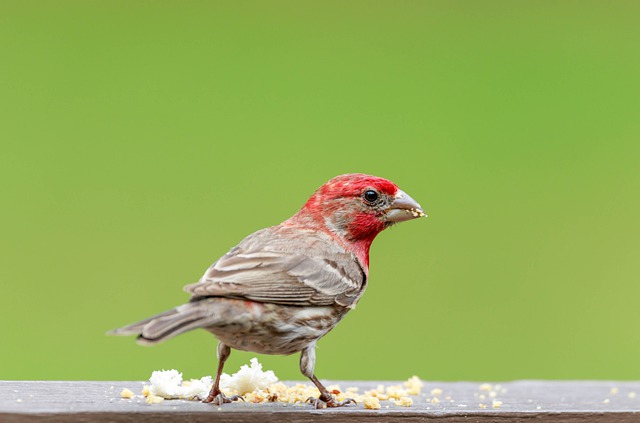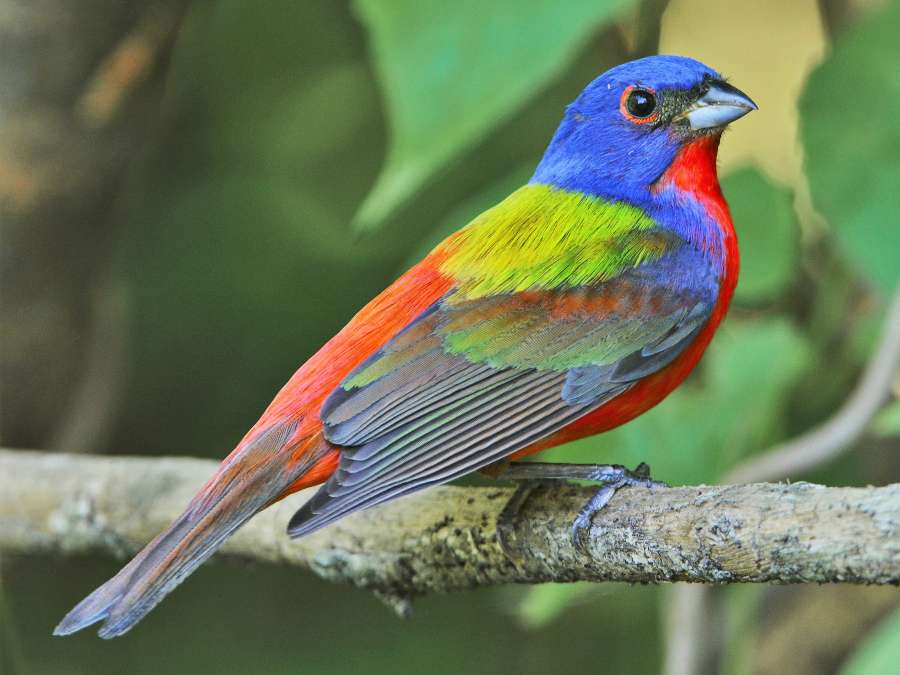If you’re trying to find some red birds in your local Floridan region, you’ve come to the right place. Here I’ll be going over 7 unique red birds in Florida that you can try spotting when on your next bird watching expedition.
- Northern Cardinal
- Male Summer Tanager
- House Finch
- Red Headed Woodpecker
- Painted Bunting
- Vermillion Flycatcher
- Scarlet Tanager
7 Red Birds In Florida
1. Northern Cardinal (Cardinalis Cardinalis)

- Size: 21 – 23cm
- Weight: 42 – 48 grams
- Wingspan: 30 – 35cm
These cardinals can be found in Florida year round as it is one of their many permanent residents within northern America.
Northern cardinals are recognised by their mohawk like head feathers, red exterior and beak with elements of black across the face. Females also have elements of red on their beaks and their body but, at smaller amounts with the majority of their plumage being a light brown color.
These cardinals can be found in woodlands, gardens, shrublands, wetlands and can even be brought into your backyard if you have sugar water or seeds that satisfy their taste buds.
As for the food they eat, it consists of small insects like beetles, true bugs, grasshoppers, caterpillars, ants, flies, spiders, centipedes, and snails. Seeds of weeds, berries among other smaller fruits are part of their diet too.
Northern cardinals are known to live for around 15 years in the wild although the actual number is far less grand.
2. Male Summer Tanager (Piranga Rubra)

- Size: 15 – 18cm
- Weight: 27 – 31 grams
- Wingspan: 28 – 30cm
Summer tanagers, as their name would suggest, can be found is Florida in the summer months whilst some do take migratory passage out of the state further south.
Male summer tanagers are recognised by their almost entirely red plumage with a grayish/silver beak. Females on the other hand are almost entirely yellow.
Summer tanagers are usually found within tropical forests of tall trees with an open canopy and mostly prefer to stay in lower elevations. They can reside within habitats that are 1800 meters above sea level too.
These tanagers mostly eat small insects like bees and wasps but, will also consume berries and smaller fruits foraged from backyards, parks among other environments rich with these food sources.
On average summer tanagers are known to live for around 5 years in the wild.
3. House Finch (Haemorhous Mexicanus)

- Size: 12.5 – 15cm
- Weight: 19 – 22 grams
- Wingspan: 20 – 25cm
These finches can be found around Florida year round as it is one of their many permanent residences within north America.
House finches have a red and brown plumage with their body mostly light brown and the head made up of a gradient red color with hints of brown. Females on the other hand are mostly brown with hints of black on their wings and back.
As for where you can find house finches, the number of habitats they stay within are quite vast ranging from dry desert, desert grassland, chaparral, oak savannah, streamsides, and open coniferous forests at elevations below 6,000 feet.
If the food is to their liking, like black sunflower seeds, these little birds will on occasion make their way to a feeder set out by a citizen. Other than seeds house finches also eat small insects like aphids as well as fruits and berries.
In the wild, house finches are known to live for around 10 years whilst captive finches can live upwards of 12 years.
4. Red Headed Woodpecker (Melanerpes Erythrocephalus)

- Size – 19 – 25cm
- Weight – 56 – 97 grams
- Wingspan – 40 – 45cm
These red headed woodpeckers can be found in Florida year round as it’s a permanent residence of theirs.
Red headed woodpeckers are recognised by their red head and their black and white body and wings. Females on the other hand have a much duller gray and white plumage.
These woodpeckers tend to spend the majority of their time in groves, farm country, orchards, shade trees in towns, large scattered trees where you can find them in forest edges, orchards, open pine woods and the groves of taller trees.
A red headed woodpecker’s diet consists of a wide variety of insects which includes spiders, earthworms, different types of nuts, seeds, berries along with other fruits. Sometimes these peckers may even eat small rodents or the contents of another birds eggs.
As for their lifespan, red headed woodpeckers have been known to live up to 10 years in the wild.
5. Painted Bunting (Passerina Ciris)

- Size: 12 – 13cm
- Weight: 13 – 19 grams
- Wingspan: 21 – 23cm
Painted buntings can be found in Florida mostly when making their migratory path through but, some further south may decide to camp in the state throughout the fall and winter months.
Although painted buntings are not completley red, a good portion of their plumage is. Their neck, breast and lower back is red, their head is blue whilst their upper back and wing is green. Females on the other hand are almost completely green.
You can find painted buntings around thickets, woodland edges with riparian thickets, shrubbery and brushy areas.
As for what they eat, it includes seeds, primarily those of grasses and weeds, berries, smaller fruits and a variety of smaller insects.
Most painted buntings can live for an average of 5 – 6 years whilst some have been known to live for 10+ years.
6. Vermilion Flycatcher (Pyrocephalus Obscurus)

- Size: 16 – 18cm
- Weight: 35 – 40 grams
- Wingspan: 30 – 32cm
These Flycatchers can be found in Western Florida when they aren’t breeding, which will be in the fall and winter months
Male vermillion flycatchers are recognised by their redish/orange plumage with gray wings, back and eyes. The females have small elements of red on their plumage although the majority of their feathers are brown.
As for where they tend to live, you will find vermillion flycatchers near streamsides, in drier more arid country, savannahs and ranches.
They will eat a variety of food sources with insects making up the majority of their diet where they will actually catch them in flight through an ambush. Berries among other smaller fruits make up the other part of their diet.
These flycatchers tend to live for around 4 – 5 years in the wild, which has the possibility of increasing for the captive variants.
7. Scarlet Tanager (Piranga Olivacea)

- Size: 16 – 19cm
- Weight: 27 – 32 grams
- Wingspan: 25 – 30cm
These tanagers will make their way through Florida when migrating so you may catch them flying through Florida at the beginning of spring or the end of summer.
Scarlet tanagers are recognised by their scarlet plumage, black wing and triangular silver/gray beak. Females are actually different in color to their male counterparts where their plumage is green with black wings.
These tanagers can be found within deciduous forest where oak maple, beech, and other trees are common. They also stay within mixed pine-oak woods, and occasionally in coniferous woods dominated by pine or hemlock.
As for what scarlet tanagers eat, it mostly consists of insects like caterpillars, moths, beetles, wasps, bees, aphids, berries and small fruits.
Scarlet tanagers can live up to 12 years in the wild although the actual lifespan for most scarlets will likely be far lower.
Amhil Khan, a dedicated nature enthusiast and the founder of BirdsOfTheWild.com, is a passionate advocate for the captivating world of avian wonders. With a deep-seated curiosity about the intricate lives of birds, Amhil’s journey began as a fascination and has evolved into a mission to inspire others to appreciate and protect these magnificent creatures.
Amhil’s love for birds led to the creation of Birds of the Wild, a platform where his expertise in ornithology, coupled with his captivating storytelling, provides readers with an immersive and educational experience. Through his lens and words, he captures the essence of birds in their natural habitats, offering a glimpse into their behaviors, migrations, and the ecosystems they inhabit.

